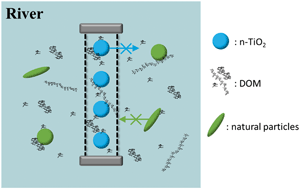当前位置:
X-MOL 学术
›
Environ. Sci.: Nano
›
论文详情
Our official English website, www.x-mol.net, welcomes your feedback! (Note: you will need to create a separate account there.)
Validation of a field deployable reactor for in situ formation of NOM-engineered nanoparticle corona
Environmental Science: Nano ( IF 7.3 ) Pub Date : 2020/01/03 , DOI: 10.1039/c9en01090d Narjes Tayyebi Sabet Khomami 1, 2, 3, 4, 5 , Allan Philippe 1, 2, 3, 4, 5 , Abd Alaziz Abu Quba 1, 2, 3, 4, 5 , Oliver J. Lechtenfeld 5, 6, 7, 8, 9 , Jean-Michel Guigner 10, 11, 12, 13, 14 , Stefan Heissler 5, 15, 16, 17 , Gabriele E. Schaumann 1, 2, 3, 4, 5
Environmental Science: Nano ( IF 7.3 ) Pub Date : 2020/01/03 , DOI: 10.1039/c9en01090d Narjes Tayyebi Sabet Khomami 1, 2, 3, 4, 5 , Allan Philippe 1, 2, 3, 4, 5 , Abd Alaziz Abu Quba 1, 2, 3, 4, 5 , Oliver J. Lechtenfeld 5, 6, 7, 8, 9 , Jean-Michel Guigner 10, 11, 12, 13, 14 , Stefan Heissler 5, 15, 16, 17 , Gabriele E. Schaumann 1, 2, 3, 4, 5
Affiliation

|
Despite the numerous studies about the sorption of dissolved organic matter (DOM) onto nanoparticles, the extrapolation of laboratory results to environmental conditions is currently impossible. Indeed, the complex dynamics of DOM under variable environmental conditions are not completely reproducible under control conditions. In this study, we propose a different approach by exploring a method for exposing nanoparticles to realistic environmental conditions in natural river water by using dialysis membranes as passive reactors. Inside this reactor, the complexity and the temporal variability of a large number of environmental parameters (DOM structure and composition, temperature, inorganic ions, pH, etc.) are reproduced, while colloidal and particulate interferences remain separated. To verify this assumption, we determined the concentration of the water components and nanoparticles (n-TiO2, 20–50 nm) inside and outside the reactor before and after exposure to river water. In river water, more than 90% of the n-TiO2 nanoparticles remained inside the reactor while DOM retained its molecular composition/characteristics after passing through the membrane (DOC, fluorescence EEM, and FT-ICR MS). For most elements and anions, the concentrations inside and outside the reactor did not differ, indicating a good permeability for inorganic constituents (IC, ICP-OES); however, the concentrations of Al, Fe, Mn, and nitrate were lower. Membrane fouling, in terms of pore size distribution, was investigated using NMR relaxometry and AFM in fluid mode; no significant reduction in pore size was observed under the applied conditions during seven days of exposure. Finally, ATR-FTIR and CHNS analysis of n-TiO2 before and after exposure to the river water revealed that sorption of DOM occurred under field conditions. Therefore, we could demonstrate the validity and the potential of this method.
中文翻译:

现场部署的NOM工程纳米粒子电晕原位形成反应器的验证
尽管对溶解的有机物(DOM)吸附到纳米颗粒上进行了大量研究,但目前尚无法将实验室结果外推到环境条件下。实际上,在可变的环境条件下DOM的复杂动力学在控制条件下不能完全重现。在这项研究中,我们通过探索将透析膜用作被动反应器,将纳米颗粒暴露于天然河水中真实环境条件的方法,提出了一种不同的方法。在此反应器内部,存在许多环境参数(DOM结构和组成,温度,无机离子,pH等)的复杂性和时间变化性。)被复制,而胶体和微粒干扰保持分离。为了验证这个假设,我们确定了水成分和纳米颗粒(N-TiO 2的浓度2之前和暴露于河水之后,20-50纳米)内部和反应器外部。在河水中,超过90%的n-TiO 2纳米颗粒保留在反应器中,而DOM在通过膜后(DOC,荧光EEM和FT-ICR MS)保留了其分子组成/特征。对于大多数元素和阴离子,反应器内部和外部的浓度没有差异,表明对无机成分(IC,ICP-OES)具有良好的渗透性;但是,Al,Fe,Mn和硝酸盐的浓度较低。就膜尺寸而言,采用核磁共振弛豫法和原子力显微镜以流体模式研究了膜的结垢。在暴露的7天中,在所施加的条件下,未观察到孔径的显着减小。最后,对n-TiO 2进行ATR-FTIR和CHNS分析暴露于河水中前后,发现在田间条件下发生了DOM的吸附。因此,我们可以证明这种方法的有效性和潜力。
更新日期:2020-02-20
中文翻译:

现场部署的NOM工程纳米粒子电晕原位形成反应器的验证
尽管对溶解的有机物(DOM)吸附到纳米颗粒上进行了大量研究,但目前尚无法将实验室结果外推到环境条件下。实际上,在可变的环境条件下DOM的复杂动力学在控制条件下不能完全重现。在这项研究中,我们通过探索将透析膜用作被动反应器,将纳米颗粒暴露于天然河水中真实环境条件的方法,提出了一种不同的方法。在此反应器内部,存在许多环境参数(DOM结构和组成,温度,无机离子,pH等)的复杂性和时间变化性。)被复制,而胶体和微粒干扰保持分离。为了验证这个假设,我们确定了水成分和纳米颗粒(N-TiO 2的浓度2之前和暴露于河水之后,20-50纳米)内部和反应器外部。在河水中,超过90%的n-TiO 2纳米颗粒保留在反应器中,而DOM在通过膜后(DOC,荧光EEM和FT-ICR MS)保留了其分子组成/特征。对于大多数元素和阴离子,反应器内部和外部的浓度没有差异,表明对无机成分(IC,ICP-OES)具有良好的渗透性;但是,Al,Fe,Mn和硝酸盐的浓度较低。就膜尺寸而言,采用核磁共振弛豫法和原子力显微镜以流体模式研究了膜的结垢。在暴露的7天中,在所施加的条件下,未观察到孔径的显着减小。最后,对n-TiO 2进行ATR-FTIR和CHNS分析暴露于河水中前后,发现在田间条件下发生了DOM的吸附。因此,我们可以证明这种方法的有效性和潜力。



























 京公网安备 11010802027423号
京公网安备 11010802027423号